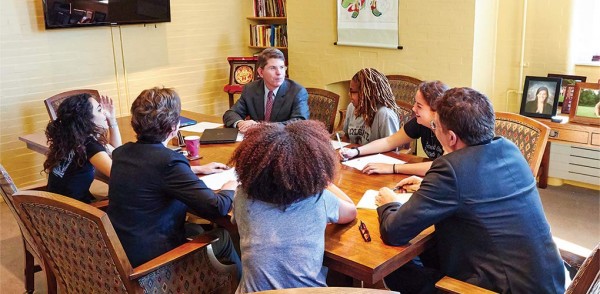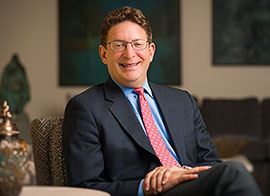When more than 150 students began a sit-in at the Hurwitz Admission Center on Monday, September 22, it was only a matter of hours before I came to believe that it would become one of the most important events in Colgate’s recent history.
You can read more about the sit-in in the news story, but here I want to share my thoughts about this student movement, the incredibly important issues behind it, and where the university is headed and why.
Deep concern about the campus climate had motivated the students of the newly formed Association of Critical Collegians (ACC) to initiate their protest. That first day of the sit-in, I listened to several dozen students speak in raw, emotional terms about greatly painful experiences that stemmed from issues of race and identity, as well as class, sexual orientation, and, for international students, national origin. They recounted occasions of when they had been insulted on campus, felt marginalized both inside and outside of the classroom, and felt unsafe. They shared the concern that Colgate was not what was promised, and that they could not fulfill their educational ambitions because of the campus climate.

President’s staff members and representatives of the Association of Critical Collegians meeting to finalize the Colgate for All road map. (Photo by Dylan Crouse ’15)
Many in the room were moved to tears by their heart-wrenching stories. As Provost Doug Hicks, Dean of the College Suzy Nelson, and I listened, it was very clear that these students were airing their grievances because they believe in Colgate and want to make our community a better place. Indeed, they all wore their Colgate gear — but emblazoned with question marks to symbolize their uncertainty about belonging in the community. The ACC posted (with permission) some of the testimonials on their YouTube channel. I encourage you to watch these.
My colleagues and I recognized immediately that these were important issues that had to be addressed, and, as an educational moment, this would help Colgate to move forward. We told the demonstrators that we were with them and we knew that candid conversation between us would be critical to develop a constructive resolution to the sit-in.
Throughout the week, a revolving group of students occupied the admission center. Some stayed continually, while some went to classes and came back. The ACC reported that nearly 400 students signed in as participants throughout the week. Several professors came by to either watch or offer support. Others held classes in the center or on the grass outside. The pep band came by to play. Food was ordered in, or donated. Students outside urged passing drivers to honk. Some students slept outside the center each night. The issues being discussed were very serious, but the mood was positive.
The more than 100 students who slept in the admission center each night were extremely well coordinated and disciplined, including cleaning up after themselves each morning. While we moved admission visits to another building, work in offices throughout the rest of the building continued uninterrupted.
Throughout the week, my senior colleagues and I met with the ACC’s representatives in intensive discussions of the 21 points in their document. What they asked for, in general, is the direction in which we in the administration indeed want to go in creating a culture of inclusivity. Some of their suggestions were already being done; many were relatively achievable. Others will have to be discussed with the larger campus community; notably, curricular issues that are the purview of the faculty. Some suggestions were simply not viable, and we explained that.
By mid-day on Friday, we were ready to release our road map for change on the new Colgate for All website. Doug, Suzy, and I, as well as a number of faculty and staff members, then joined several hundred students as they marched out of the admission center, up to and around the Academic Quad and down to Broad Street. It was wonderful to hear students who began the sit-in expressing so much hurt chanting, among other things, “We are Colgate!”
Understandably, we have heard from alumni who view these events through their own experiences and who have expressed everything from dismay that these issues are still happening here, to skepticism about the potential for real change, to concerns about free speech. Many also expressed their pride in Colgate, in the students who care so deeply, and in Colgate’s collaborative response. We appreciate feedback of all kinds. Part of having an inclusive campus also means being able to discuss issues about which people feel strongly and disagree. We can only have those conversations if everyone feels they have a voice.
We have already begun work on what we promised to do and are committed to executing what we agreed upon as quickly as possible. And we will communicate our progress in a clear and transparent manner. Our ultimate goal is the same as the students’ — to create a Colgate community that welcomes all, where we learn from each other, and where all can reach their full academic and social potential.
Read the plan and follow updates at colgate.edu/forall. Multimedia and photos at colgate.edu/forall-video and colgate.edu/forall-photos.







